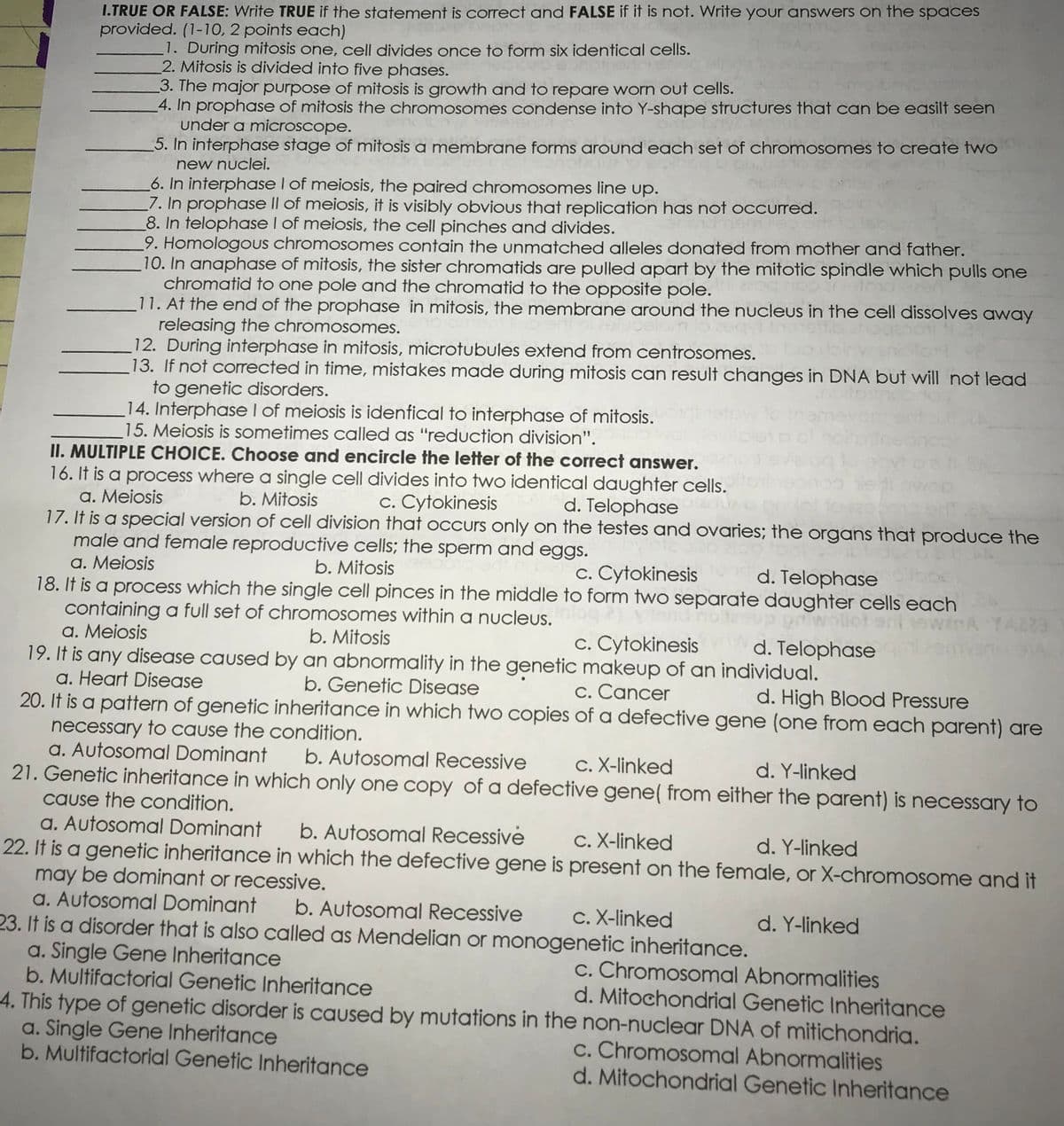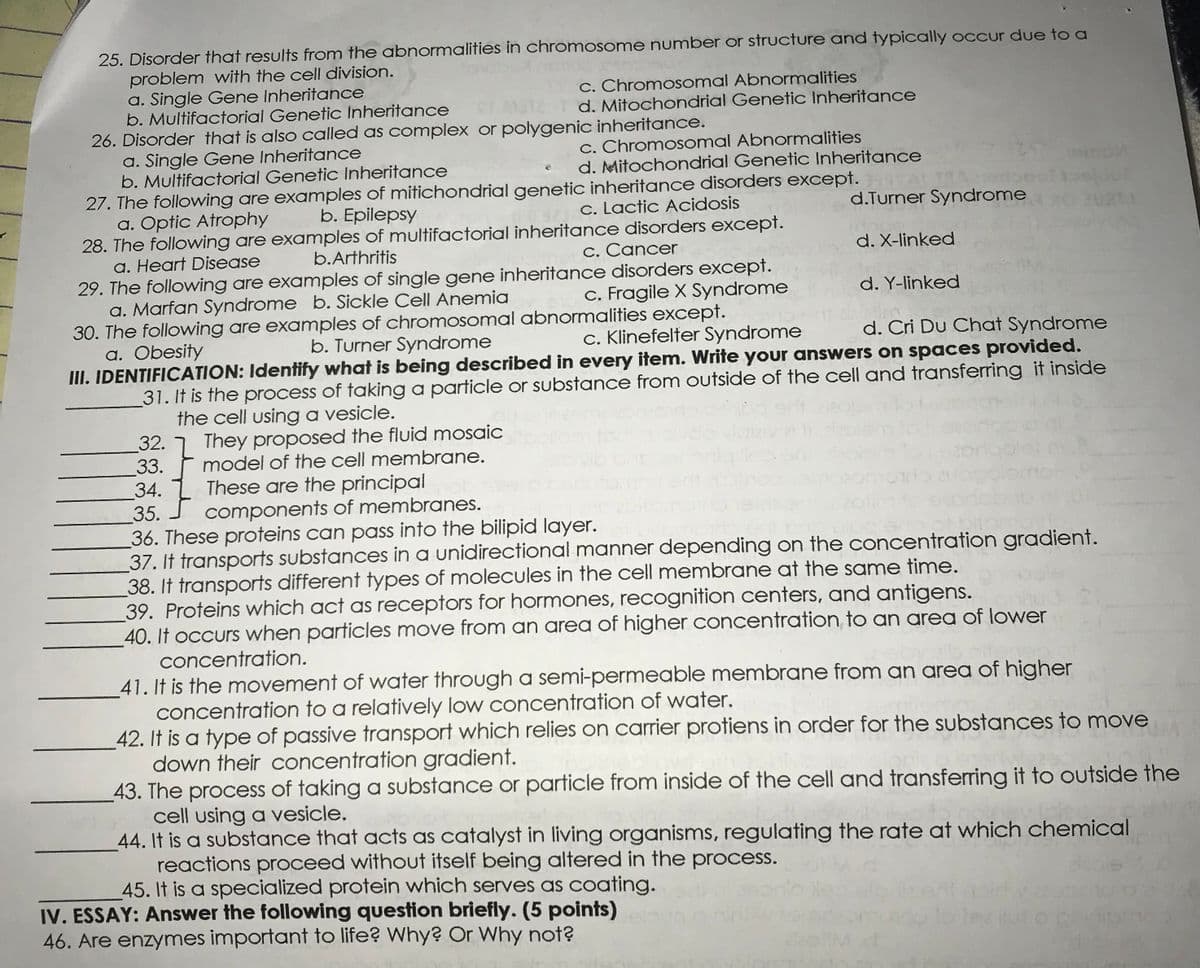_1. During mitosis one, cell divides once to form six identical cells. 2. Mitosis is divided into five phases. 3. The major purpose of mitosis is growth and to repare worn out cells.
_1. During mitosis one, cell divides once to form six identical cells. 2. Mitosis is divided into five phases. 3. The major purpose of mitosis is growth and to repare worn out cells.
Chapter21: Oncology (cancer Medicine)
Section: Chapter Questions
Problem H9CRE
Related questions
Concept explainers
Oogenesis
The formation of the ovum (mature female gamete) from undifferentiated germ cells is called oogenesis. This process takes place in the ovaries (female gonads). Oogenesis consists of three stages known as the multiplication phase, growth phase, and maturation phase.
Cell Division
Cell division involves the formation of new daughter cells from the parent cells. It is a part of the cell cycle that takes place in both prokaryotic and eukaryotic organisms. Cell division is required for three main reasons:
Question

Transcribed Image Text:I.TRUE OR FALSE: Write TRUE if the statement is correct and FALSE if it is not. Write your answers on the spaces
provided. (1-10, 2 points each)
1. During mitosis one, cell divides once to form six identical cells.
2. Mitosis is divided into five phases.
3. The major purpose of mitosis is growth and to repare worn out cells.
4. In prophase of mitosis the chromosomes condense into Y-shape structures that can be easilt seen
under a microscope.
5. In interphase stage of mitosis a membrane forms around each set of chromosomes ta create two
new nuclei.
6. In interphase I of meiosis, the paired chromosomes line up.
7. In prophase Il of meiosis, it is visibly obvious that replication has not occurred.
8. In telophase I of meiosis, the cell pinches and divides.
9. HomologOUs Chromosomes contain the unmatched alleles donated from mother and father.
10. In anaphase of mitosis, the sister chromatids are pulled apart by the mitotic spindle which pulls one
chromatid to one pole and the chromatid to the opposite pole.
11. At the end of the prophase in mitosis, the membrane around the nucleus in the cell dissolves away
releasing the chromosomes.
12. During interphase in mitosis, microtubules extend from centrosomes.
13. If not corrected in time, mistakes made during mitosis can result changes in DNA but will not lead
to genetic disorders.
14. Interphase l of meiosis is idenfical to interphase of mitosis.
15. Meiosis is sometimes called as "reduction division".
II. MULTIPLE CHOICE. Choose and encircle the letter of the correct answer.
16. It is a process where a single cell divides into two identical daughter cells.
d. Telophase
a. Meiosis
b. Mitosis
c. Cytokinesis
17. It is a special version of cell division that occurs only on the testes and ovaries; the organs that produce the
male and female reproductive cells; the sperm and eggs.
a. Meiosis
18. It is a process which the single cell pinces in the middle to form two separate daughter cells each
containing a full set of chromosomes within a nucleus.
a. Meiosis
19. It is any disease caused by an abnormality in the genetic makeup of an individual.
a. Heart Disease
20. It is a pattern of genetic inheritance in which two copies of a defective gene (one from each parent) are
b. Mitosis
c. Cytokinesis
d. Telophase
AYAZ23
b. Mitosis
c. Cytokinesis
d. Telophase
b. Genetic Disease
C. Cancer
d. High Blood Pressure
necessary to Cause the condition.
a. Autosomal Dominant
21. Genetic inheritance in which only one copy of a defective gene( from either the parent) is necessary to
b. Autosomal Recessive
c. X-linked
d. Y-linked
cause the condition.
a. Autosomal Dominant
22. It is a genetic inheritance in which the defective gene is present on the female, or X-chromosome and it
may be dominant or recessive.
a. Autosomal Dominant
23. It is a disorder that is also called as Mendelian or monogenetic inheritance.
a. Single Gene Inheritance
b. Multifactorial Genetic Inheritance
4. This type of genetic disorder is caused by mutations in the non-nuclear DNA of mitichondria.
a. Single Gene Inheritance
b. Multifactorial Genetic Inheritance
b. Autosomal Recessive
c. X-linked
d. Y-linked
b. Autosomal Recessive
c. X-linked
d. Y-linked
c. Chromosomal Abnormalities
d. Mitochondrial Genetic Inheritance
c. Chromosomal Abnormalities
d. Mitochondrial Genetic Inheritance

Transcribed Image Text:25. Disorder that results from the abnormalities in chromosome number or structure and typically occur due to a
problem with the cell division.
a. Single Gene Inheritance
b. Multifactorial Genetic Inheritance
26. Disorder that is also called as complex or polygenic inheritance.
a. Single Gene Inheritance
b. Multifactorial Genetic Inheritance
27. The following are examples of mitichondrial genetic inheritance disorders except.
a. Optic Atrophy
28. The following are examples of multifactorial inheritance disorders except.
a. Heart Disease
29. The following are examples of single gene inheritance disorders except.
a. Marfan Syndrome b. Sickle Cell Anemia
30. The following are examples of chromosomal abnormalities except.
a. Obesity
C. Chromosomal Abnormalities
d. Mitochondrial Genetic Inheritance
c. Chromosomal Abnormalities
d. Mitochondrial Genetic Inheritance
b. Epilepsy
c. Lactic Acidosis
d.Turner Syndrome
b.Arthritis
c. Cancer
d. X-linked
c. Fragile X Syndrome
d. Y-linked
d. Cri Du Chat Syndrome
III. IDENTIFICATION: Identify what is being described in every item. Write your answers on spaces provided.
b. Turner Syndrome
C. Klinefelter Syndrome
31. It is the process of taking a particle or substance from outside of the cell and transferring it inside
the cell using a vesicle.
32.
33.
34.
35.
36. These proteins can pass into the bilipid layer.
37. It transports substances in a unidirectional manner depending on the concentration gradient.
38. It transports different types of molecules in the cell membrane at the same time.
39. Proteins which act as receptors for hormones, recognition centers, and antigens.
40. It occurs when particles move from an area of higher concentration to an area of lower
They proposed the fluid mosaic
model of the cell membrane.
These are the principal
components of membranes.
concentration.
41. It is the movement of water through a semi-permeable membrane from an area of higher
concentration to a relatively low concentration of water.
42. It is a type of passive transport which relies on carrier protiens in order for the substances to move
down their concentration gradient.
43. The process of taking a substance or particle from inside of the cell and transferring it to outside the
cell using a vesicle.
44. It is a substance that acts as catalyst in living organisms, regulating the rate at which chemical
reactions proceed without itself being altered in the process.
45. It is a specialized protein which serves as coating.
IV. ESSAY: Answer the following question briefly. (5 points)
46. Are enzymes important to life? Why? Or Why not?
Expert Solution
This question has been solved!
Explore an expertly crafted, step-by-step solution for a thorough understanding of key concepts.
This is a popular solution!
Trending now
This is a popular solution!
Step by step
Solved in 2 steps

Knowledge Booster
Learn more about
Need a deep-dive on the concept behind this application? Look no further. Learn more about this topic, biology and related others by exploring similar questions and additional content below.Recommended textbooks for you





